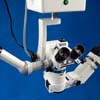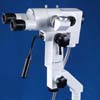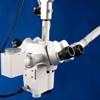Colposcopy in Cervical Cancer
Aside from breast cancer, one of the leading causes of cancer death in females is cervical cancer. This latter can be diagnosed by pap smear where the gynaecologist would gather cell samples from the patient’s cervix in order to look it under the clinical microscope for malignant or cancerous changes in the cervix. A regular Pap smear test is recommended for women who are sexually active since it is known that the prostaglandin found in semen might trigger the development of tumours in the cervix and the surrounding areas. Sometimes, however, Pap smear tests are not enough to look at the possible abnormalities that can be found in the patient’s cervix and the gynaecologist might refer her to another examination using a gynaecological colposcope.Colposcopy is different from Pap smear testing in that it doesn’t require any medical instruments to enter the cervix while doing the examination itself. However, if the gynaecologist decides upon inspection that a biopsy needs to be done, local anaesthesia would be used before the doctor takes away cells or tissues from the patient’s cervix for further assessment. This would be followed by endocervical curettage (ECC) which entails scraping the cervical canal with a curette. ECC should never be done to pregnant women, and this is perhaps the only part of the colposcopy procedure that may cause discomfort or even pain for the patient.
On all other matters, colposcopy is something like looking at the cervix under magnification. A colposcope is a low-power binocular microscope that has an illumination that points straight out as well as the microscope lens towards where the patient would be lying down. This kind of microscope would also have a camera attached to it so that the gynaecologist can take records of the patient’s cervix and even project the doctor-view onto a monitor so that the patient can also see what is happening during the examination proper.
Colposcopy is done with the patient in the same position as if she was undergoing Pap smear testing, with her legs held up by stirrups and in the dorsal lithotomy position. The gynaecologist would then use a speculum, which is like a spatula, to look at the vulva and see if there are abnormal lesions. Sometimes, an iodine solution would be used for the doctor to highlight parts of the cervix and the surrounding areas where there are abnormalities. These latter do not mean that there are malignant changes in the patient’s cervix, however. This is when a biopsy would be helpful for the gynaecologist to further view the patient’s tissues and test it for cancerous growth. If there seem to be abnormal tissues detected during colposcopy, the gynaecologist would usually opt to perform extraction or Loop Diathermy might be done to remove the abnormal tissues and see if there are signs of cervical cancer.
There are no complications that might result from colposcopy unless the patient had undergone biopsy. This is especially helpful for pregnant women who need to have cervical examination so as to make sure that the procedure would cause no adverse effects on the fetus. Without the need for anaesthesia and actual penetration, cervical examination using the colposcope can very well be considered a safe and accurate way of looking at the cervix.
Back to Articles
call toll-free: 877-215-3795 or email


Categories
Categories
Dental
Dental Microscopes
Dental Microscopes
Ophthalmic
Ophthalmic Microscopes
Ophthalmic Microscopes
Gynecology
Gynecology Colposcopes
Gynecology Colposcopes




